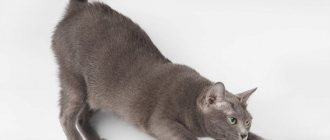History of the Siamese cat breed
Siamese cat
Documentary evidence of the existence of a particular breed cannot always accurately indicate its age, because after the advent of writing, the first chronicles were written on fragile natural materials: tree bark, papyrus, palm leaves. Of course, over time, such scrolls were destroyed.
Sometimes they managed to make “lists” from them, that is, manually created copies, to which changes and additions were often made. Therefore, it is difficult to say exactly when the original scientific treatise “Tamra Maew” was written - a poetic description of various cats that lived in the territory of modern Thailand. According to hypotheses, this happened during the existence of the Kingdom of Ayutthaya (Ayutthaya), that is, between 1351 and 1767. However, the surviving copies of the poem, which are in the royal Buddhist temple Wat Bowon in Bangkok and the British Library in London, date back to the mid-19th century.
Be that as it may, on sheets of ancient paper made from the bark of a Thai variety of mulberry tree, 23 cats of different breeds are depicted. Six of them, according to the author, bring misfortune to a person, and the rest help to attract good luck. Among the latter, Wichienmaat stands out - a proportionally built white cat with dark hair on its face, ears, paws and tail.
For a long time, these animals were considered sacred; they lived in the temples of Siam (as Thailand was called until the middle of the last century) and at the court of local monarchs. Possession of them by mere mortals, much less taking them out of the country, was strictly prohibited. The Western world learned about the existence of Siamese cats only towards the end of the 19th century.
Siamese kitten
In 1872, at the famous London exhibition hall Crystal Palace, an unusual cat from Central Asia was presented to the public. The reaction of specialists and ordinary people was ambiguous; there was even a journalist who awarded the overseas guest the epithet “nightmare.” However, many breeders were not so much afraid as they were intrigued by Dorothy Neville’s favorite. However, due to problems with exports, there was no talk of developing the breed. Only in 1884, the British Ambassador Owen Gold brought a promising couple to Foggy Albion for his sister: a neat cat with rounded outlines, Mia, and a slender, elongated body kitten, Fo. Just a year later, one of their heirs became champion. Soon the first European standard was approved, a club for breed lovers was created, and selection work began.
A little earlier, in 1878, US consulate employee David Sickels made a gift to the presidential couple, Rutherford and Lucy Hayes. The fact that the Siamese kitten was sent to America by ship is evidenced by a cover letter from a diplomat, which is kept in the archives of the Hayes Presidential Center in Fremont, Ohio. Just two decades later, oriental cats became very popular in the New World.
Among the famous owners of “moon diamonds” (as Siamese are called in their homeland), one can recall another American president, Jimmy Carter, the founder of Pink Floyd, Syd Barrett, writer Anthony Burgess, winner of two Oscars Vivien Leigh, British Prime Minister Harold Wilson, legendary musician John Lennon, actor Gary Oldman and others.
Siamese cat in motion
Taking sunbathing
Origin story
The long history of the origin of Siamese cats deserves attention. The graceful creatures look like panthers, which is very logical. If we rely on historical information, we can say that for a long time the animals remained wild. This is precisely what their incredible similarity with lionesses and panthers, which always demonstrate their strength and grace, speaks of. The birthplace of Siamese cats is ancient Siam. Currently it is Thailand.
About 600 years ago, monks came up with the idea to tame these cute creatures. Cats were even taken to all sorts of ceremonies, both solemn and not solemn. Gradually, animals became guardians of temples and guides of people's souls to another world. However, no one was allowed to touch the sacred cats except the clergy themselves and representatives of the royal family. This situation persisted for many centuries, until in the second half of the nineteenth century the king of Thailand decided to send several dozen animals as gifts to European rulers. Such an act looked like an act of nobility and respect. The royal families appreciated the graceful animals and liked them. And by the end of the nineteenth century, Queen Victoria herself was actively breeding a new breed. It is thanks to this that the animals have become so popular even far from the homeland of Siamese cats. Currently, representatives of this breed can be found in every corner of the world.
Appearance of a Siamese cat
As mentioned above, there are significant differences in breed standards. Most associations believe that the Siamese cat should have a slender but muscular body with elongated lines, and cats with smoother and more rounded features are classified as the Thai breed (or they are called traditional Siamese cats). Siamese cats are small in size, weighing from 2.5 to 6 kilograms.
Head
Wedge-shaped, long and tapering from the narrow point of the nose to the tips of the ears, forming a triangle.
Ears
The ears of Siamese cats are unusually large, wide at the base, pointed at the end, repeating the same triangular shape as the head.
Eyes
Medium size, almond-shaped, somewhat obliquely set. Always have a deep bright blue color.
Siamese cat face
Body
Elongated, flexible, muscular.
Limbs
Long and thin, the rear ones are higher than the front ones. The paws are small, graceful, oval in shape.
Tail
The tail of Siamese cats is long and thin, tapering towards the tip.
Wool
Short, fine texture.
Siamese cat teeth
The eyes of Siamese cats are always a rich, bright blue color.
Color
The Cat Fanciers Association allows four colors of Siamese:
Siamese cat at an exhibition
- seal point, pale yellow to cream with contrasting brown spots on the feet, tail, ears, face, brown nose and paw pads;
- chocolate point, an ivory base with milk chocolate spots, brown-pink nose and paw pads;
- blue point, bluish-white body with gray-blue spots, slate gray nose and paw pads;
- lilac point, white body with pink-brown spots, lavender-pink nose and paw pads.
The International Cat Association considers a normative range beyond the four color-point colors recognized by the CFA. It includes the Pointed Tabby, the Red Pointer, the Cream Pointer, and the Pointer with Tortoiseshell markings.
Description of the Siamese breed
Representatives of the Siamese breed belong to the group of Siamese-Oriental animals. They have a specific appearance, which is emphasized by a wedge-shaped head, large ears and bright blue eyes.
The flexible body fits well with the head. It has muscular limbs and paws.
Due to their miniature size, Siamese are difficult to confuse with other cat breeds. The graceful appearance is complemented by unusual eyes and a smart look. Other features, descriptions and characteristics of the breed:
- Body mass. An adult pet can weigh from 3 to 5 kg. After sterilization, the weight reaches 7 kg.
- Height. Being a miniature member of the cat family, the Siamese grows up to 23-25 cm in height. In this case, the total body length can reach 55-60 cm.
- Lifespan. With proper care for pets, their average life expectancy can reach 14-25 years. A cat who lived for 38 years was included in the Guinness Book of Records.
- Character. Siamese pets are independent and self-sufficient creatures that can be stubborn, but retain an innate hunting instinct. They often behave stubbornly, but quickly get used to one owner and remain faithful to him all their lives.
- Intelligence. Siamese cats demonstrate quick wit and high intelligence.
They are jealous of their owner towards other people, are able to notice any changes in his mood, are ready to play for a long time and actively and be the center of attention.
Myths about the viciousness of cats are associated with the presence of bends in the tail, which were previously allowed by the standard, but were excluded due to the development of vertebral pathologies. Feeling discomfort, the owners of such defects were nervous and did not show cheerfulness.
Cat color
Newborn animals are similar to albinos because... they are born almost white. Siamese kittens begin to darken only after 2 weeks, and the final fixation of coat color occurs at 8-10 months of age.
Dark spots are present on the face, paws, ears and tail, due to the small amount of pigment in the warm parts. As they grow older, the difference between such dots and the general coloring is practically not visible.
The color standard provides for the following varieties of Siamese cats:
- Blue point - blue.
- Lilac point - lilac.
- Red point is red.
- Chocolate point - chocolate.
- Lalaik point.
- Cinnamon Point.
In the homeland of Siamese cats, no more than 18 shades of coat are allowed.
Varieties
When considering the Siamese cat breed, you need to take into account that only a few species belong to the group of Siamese-Oriental pets. The first facts about Siamese cats appeared in the 16th-17th centuries. Then the group consisted of the following breeds:
- Siamese. Representatives of the breed have a thin build, an elongated neck and a wedge-shaped head. The limbs are long and thin. The listed signs of a Siamese cat are typical for any subspecies.
- Thai. The differences between the Thai species and the Siamese are in the smooth transitions of lines and increased body density.
- Oriental. Pets have a muscular body and a wedge-shaped head. Their coat may be spotted or unmarked.
- Mekong Bobtail. Such animals are practically no different from Siamese. But unlike Siamese individuals, they are born with a small tail stub - a bob.
Intensive breeding efforts have led to the development of additional breeds, including the Himalayan, Burmese, Balinese and Seychelles. Representatives of the listed varieties differ in different coat lengths, character and behavior.
Character of Siamese beauties
The character of the Siamese cat is quite docile and friendly. Animals are freedom-loving and independent. And although they interact with people for a long time, this does not prevent them from displaying the habits of independent predators, trying to subjugate their owners to their rules.
Pets behave cunningly and cannot tolerate authoritarian attitudes towards themselves. However, Siamese cats remain loyal and maintain a noble demeanor.
Any long separation from the owner causes sadness and boredom in the pet. When he is often alone, he begins to be capricious and shows aggression. When living together with other pets, Siamese behave calmly, but on the condition that no one claims their territory and personal space.
Despite getting used to one place, cats are not afraid of long journeys, during which they remain attached to their owners and do not leave them.
Animals lead an active lifestyle and do not refuse the opportunity to play pranks. Before you bring a Siamese animal into your home, you need to make sure you are ready to spend a lot of time with it and clean the building after playing.
The pet knows how to communicate with its owner, demonstrating its mood with sounds and voice. If you are patient and learn this behavior, it will make your cat's future training easier.
Despite their waywardness and pride, representatives of the breed are trainable and stop mischief if you teach them the basic rules. Breeders still cannot understand how such different character traits are combined in one creature, including vindictiveness, aggressiveness, tenderness and meekness.
Photos of Siamese cats
Character of Siamese cats
Siamese cats skillfully use their vocal cords, easily change the tonality and pitch of sound to express feelings.
There is an opinion that all Siamese cats have an unbalanced character, are touchy, vengeful and simply aggressive. Breeders who have been working with the breed for many years are confident that such words are unfair. Yes, these are quite capricious and demanding pets, so they should not be owned by people who dream of an easygoing companion who will behave as quietly as possible.
For Siamese, communication is as vital a necessity as food and water. And it’s not just about playing together and affection! They literally talk to the owner, using a loud voice and expressive intonations, reporting everything they like or don’t like, are interested in, worry about, or irritate. After being separated for several hours, a detailed “report” about what happened during the day will be waiting for you, and your pet, of course, expects a response to his tirades; he will be happy to support the conversation.
By the way, Siamese cats are very sensitive to emotions expressed in human speech, they are offended by an angry, rude tone, so do not raise your voice unless necessary - it has long been proven that animals can also experience depression, which leads to negative consequences for physical health.
Siamese cats are attached to their family members, do not like loneliness, and will readily accompany you while moving around the apartment and “help” with household chores. And when you finally settle down in a chair with a laptop or a book, they will gently snuggle against your warm side and purr with pleasure.
Impressionable royals are not so patient as to constantly communicate with children under the age of 6-7 years, who do not understand the boundaries of personal space and, in their delight at the sight of a beautiful “kitty,” forget that a living creature cannot be treated as unceremoniously as a plush one. a toy. Siamese cats treat older children quite well.
As for other pets, no one can guarantee you peace and harmony in the house, although some Siamese make friends with dogs. If one pet is not enough for owners or they want to protect their furry family members from loneliness while everyone is at work, the best option would be to simultaneously purchase two Siamese kittens.
The Siamese cat is quite jealous, therefore, if the owner has a desire to have another pet, he needs to think through everything clearly and consult with a specialist. By the way, such cats are wary of strangers.
Because cats love freedom, they feel quite normal if they have to stay home alone for a long time. But when the owner returns, he should communicate with his pet - representatives of the breed love to play.
FAQ
How many live at home?
Cats living in a family can live a long life - 15-25 years. Among the representatives of the breed there are long-lived cats that have lived for more than 35 years.
What is the weight of an adult and a kitten?
Siamese cats are slightly larger than females. At three months, cats weigh 1-1.5 kg, females - 1.3-2.8 kg. By six months, cats reach a weight of 1.7-2.4 kg, males - 2.3-4.1 kg. Adult females weigh 3.1-4.2 kg, males - 4-6.1 kg.
Is it easy to hold?
Siamese are affectionate and gentle towards their people. They can walk on their hands and sit on their knees. There are individuals who greet you at the doorstep and ask to be held in your arms. They may not go to strangers.
Can I keep it outside?
No. These cats are very sensitive to cold. They cannot be kept even in a cold room.
How aggressive is the breed?
The aggressiveness of Siamese cats is legendary. But these are just legends. True purebred Siamese are affectionate pets that become attached to people. The myth of vindictiveness and aggressiveness appeared in the Soviet years, when cats with genetic defects and psychological problems were imported into the country. Modern purebred Siamese are smart, willful, but not aggressive.
Do they like to claw/climb?
They love you if they are bored. Don't leave your pets alone for long periods of time and provide them with toys they can play with while you're away.
Is this breed hypoallergenic?
The short-haired Siamese poses a potential danger to allergy sufferers. The Balinese cat, which is sometimes called the longhaired Siamese, is considered less allergenic and is related to the Siamese.
Do you need to take care of your fur?
Minimal grooming is required - the breed has short hair without undercoat. Some owners simply run a damp hand over the animal's fur to remove dead hair. You can brush your Siamese once a week with a natural bristle brush or a sparse comb.
What color are eyes?
Cats of this breed have rich blue or blue eyes. Do not believe those who offer you a purebred Siamese cat with a different eye color. Green, copper and yellow colors are a breed defect.
Is the breed prone to heart disease?
Unfortunately, Siamese cats have a hereditary predisposition to heart pathologies. Such as heart enlargement and aortic stenosis.
At what age do they stop growing?
Siamese kittens reach adult size by 2 years. By this time, the color of the coat and eyes should have finally formed. In some individuals, the growth process is completely completed at 1.5 years.
Reviews from Siamese cat owners
Kirill : “I named my Siamese cat Klitschko. Moreover, initially he was Piglet, but the fighting qualities of the cat determined his name and future fate. They say that Siamese cats are fighters. They say the truth. But, respecting my cat, I will say that people have never suffered from his long claws, but furniture and curtains have suffered regularly! Klitschko, my friend, is stubborn. He immediately refused to eat ready-made food, even though I offered him the most expensive options, he only eats human food, including bread and butter and caramels. I know it’s harmful, but that’s how it happened historically.”
Nikita : “When the blue-eyed kitten from the entire litter jumped into my arms, the bearded engineer’s heart trembled. I named it Pepper, in the hope that it will grow into a cool pepper. Pepper is still growing. What can I say - the character, like all Siamese, is sharp. Firstly, he decided that the bathroom was a wonderful toilet, large and white, and so far he could not be dissuaded. Secondly, this impudent guy only sleeps on my head. It feels like I'm growing another beard at night. But that's where its shortcomings end. Perchik is a real man’s cat, brutal and childish at the same time.”
Slava : “Very often cats with a similar color are called Siamese. This is where the myth about their aggressiveness, vindictiveness and sloppiness came from. In fact, true Siamese cats are an elegant breed in every sense. They are delicate and unobtrusive, even when they miss their owner, Siamese cats do not beg for affection, but intelligently wait for it. Of course, familiarity is not in their favor, but if you remember this, you can build a wonderful partnership with your Siamese cat.”
Video reviews:
Care and maintenance
It's time for someone to go on a diet
Preferably kept at home with short walks under human supervision. These sophisticated creatures have lived in warm tropical climates for centuries, so they do not have the cold tolerance that their Norwegian or Siberian counterparts boast.
At the same time as the kitten, the house should have a permanent place for feeding, a calm and comfortable corner for the toilet with a suitable tray, toys designed to train not only muscles, but also the intellect. It is advisable to buy a cat tree house so that your Siamese can feel like a brave conqueror of peaks and look down on everyone a little.
The structural features of the short, smooth coat make caring for Siamese cats as simple and tireless as possible. Frequent bathing is contraindicated, since the lack of a natural fat barrier impairs the immune system. Cats are very clean and keep themselves in good shape. It is enough to go over the entire “fur coat” once or twice a week with a special comb-comb – and your pet will look 100% perfect. Of course, provided that he is provided with proper nutrition.
The easiest way to organize a complete diet for animals of any age is with ready-made premium and super-premium food. In this case, constant access to fresh water is especially important.
To avoid problems with the oral cavity, regular brushing with pet toothpaste and a special brush that fits on the owner’s finger is recommended. Preventive examinations in a good veterinary clinic are designed to prevent the development of other ailments.
How to care for a Siamese cat
You can comb it once every 7-10 days with a soft brush and wet hands, from head to tail. They love polishing with suede cloth. This gives the coat a shine. It is necessary to bathe periodically.
Ears uncovered by fur accumulate dirt; they need to be cleaned once every 30 days.
Teeth. Cats of this breed have dental problems. Therefore, it is necessary to get into the habit of brushing your teeth. This procedure is also done once every 30 days.
Food. They love to eat tasty and a lot. It is necessary to protect your pet from overeating.
Temperature regime. They feel comfortable in the warmth. You should be careful about hypothermia.
Health and diseases of the Siamese cat
Like other purebred animals, Siamese cats are prone to developing certain diseases.
- Amyloidosis is a pathological accumulation of protein in the kidneys, liver or pancreas, which leads to dysfunction of these organs, including their failure. It occurs much less frequently than in Abyssinian cats, but it is worth remembering this risk, because a currently incurable disease, if detected at an early stage, can be significantly slowed down.
- Asthma and other bronchial diseases.
- Congenital defects of the cardiovascular system, such as aortic stenosis or distension of the heart chambers (dilated cardiomyopathy).
But in general, Siamese are healthy animals, their average life expectancy is 11-15 years, and there are also long-livers.
Behavior and character
Even when the animal is a kitten, it is distinguished by affection, increased sociability and intelligence, which is manifested in fulfilling more requests and orders of the owners. Almost immediately, an interesting and lasting contact with the owners arises; they like to be aware of what is happening to them and what the owners are doing at one time or another.
Depending on their mood, furry cats can make higher or lower sounds. That is why, in the event of an unwanted disease, a person will immediately understand it by the cat’s behavior.
Such furry animals require a high level of care from their roommates. They easily find a common language with other cats, regardless of breed or origin. There are known cases when Balinese cohabited with dogs and even snakes. Interesting videos and photos of Siamese longhaired cats that best demonstrate their appearance and temperament can be seen on the Internet.
© shutterstock
How to choose a kitten
Sleepy kingdom
In the case of Siamese cats, the advice common to all purebred animals is relevant: you can only trust well-established nurseries and breeders whose reputation is impeccable. In such conditions, we can talk not only about guaranteeing the purity of the breed, but also about concern for obtaining genetically healthy offspring.
It should be remembered that kittens are born with a uniform light coat, and acquire “signature” dark spots as they grow up. Meeting the parents can give you a rough idea of what the baby will look like in a few years.
The main guidelines should be personal sympathy and the health of the future pet. Suspicions are caused by apathy, poor appetite, bloated stomach, mucous discharge from the eyes or nose, and reluctance to make contact with a person.
Important indicators are not only the presence of a pedigree and age-appropriate vaccinations, but also decent living conditions for mothers and kittens: a spacious, clean room with soft bedding that protects from the cold, and a sufficient number of toys that promote harmonious development.
Reviews of Siamese cats
- Lyudmila.
I don’t know who constantly says that Siamese cats are terribly angry and aggressive. Our Salma did not want to eat food until she first moved into our home, in a new place for herself. Then she did not want to sit in her arms. Afterwards, she quite quickly became part of our friendly company of four people and a Sphynx cat. Today she climbs to all available heights, loves to study the contents of packages and boxes, and sleeps only in her master’s bed. During all the time that she has been with us, I have not seen a single negative feature of her character. I present a photo of my favorite Siamese cat .
- Anastasia.
I was given a tiny Siamese kitten as a gift right before I moved into a new apartment. I was happy for a couple of weeks and then moved out, leaving the pet with my parents. As soon as six months had passed, I came to visit and simply did not recognize the kitten: she grew up and became a real mistress of the house. Her favorite is dad: she follows him everywhere, if he goes into the toilet, she screams and literally tries to break down the door. She was jealous of me, or maybe she was taking revenge for the fact that I left: I never became her own, and at every opportunity she hissed at me and scratched me. I think that such cats are suitable for lonely people, since they still choose only one beloved owner.
- Peter.
Our Guinya almost immediately met the other two cats living in the house, then he ate and lay down to rest. Even today he is very friendly both with all household members and with his neighbors’ animals; he does not trust strangers, but treats them without aggression. I want to say that this is a very beautiful animal, elegant, and the look of its bright blue eyes is very intelligent and piercing. What someone might not like is the cat’s great energy: he explored absolutely every place in the house. It happens that when I return home, I find a mess - objects have been thrown off tables and cabinets, and there are scraps of torn paper on the floor. Here is a photo of my Siamese cat .
- Sveta.
Siamese are often confused with other cats of a similar color. This is where the legends about their anger, sloppiness and aggressiveness originate. In reality, these pets are incredibly elegant and graceful. Naturally, they do not particularly like familiarity, but if you clearly remember this, you can build a wonderful, harmonious and incredibly strong relationship with your pet.
Photos of Siamese kittens
How much does a Siamese cat cost?
The price of a Siamese kitten largely depends on the success of its parents at exhibitions, color, and individual characteristics (compliance with the breed standard).
The city and the eminence of the nursery are also of some importance. On average, for a kitten that can become a pet, but does not claim championship titles, they ask from 6 to 25 thousand rubles. A future exhibition participant will cost the owners at least 27-35 thousand rubles. The cost of a kitten that is bought “for breeding” starts from 50 thousand rubles.
Relationship with a person
As mentioned above, Siamese cats are well aware of their owner’s regime and adapt well to it. They often wake up their owner a couple of minutes before the alarm goes off and dive into bed when he usually goes to bed.
Let's talk about the attitude of the Siamese towards children. It is better not to have Siamese cats in houses and apartments where small children live. They don’t understand that this is a “human kitten” in front of them, so if they don’t like something, they might scratch it.
Cats of this breed will closely watch how you fuss with your child, be quietly jealous and harbor resentment. If you find out that you are expecting a new addition soon, then it’s time to look for a new home for your pet.











